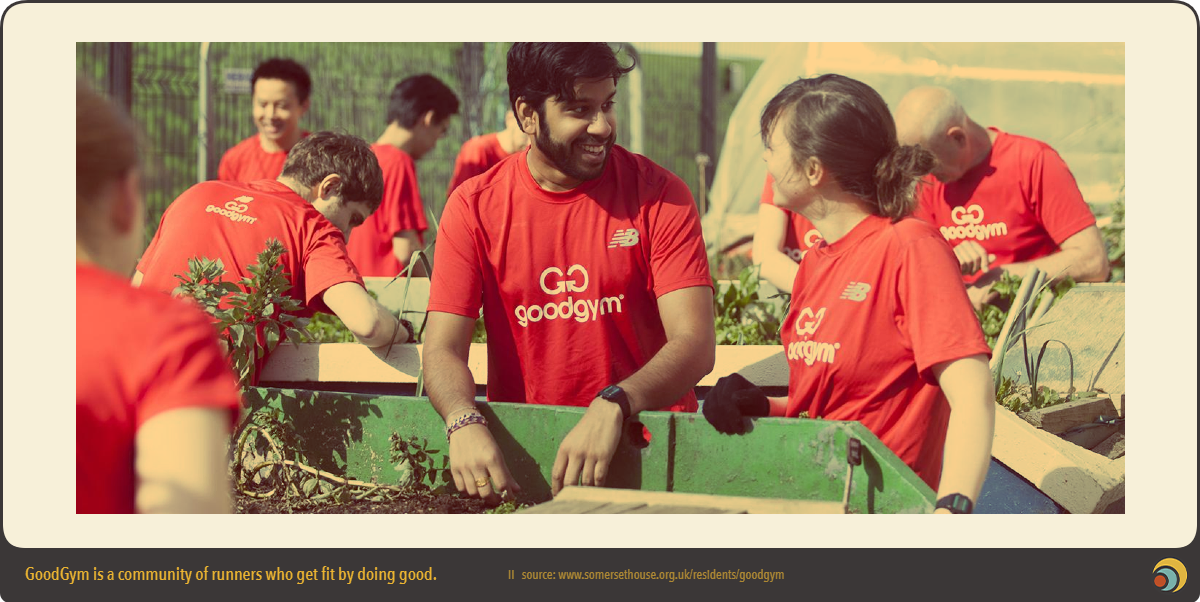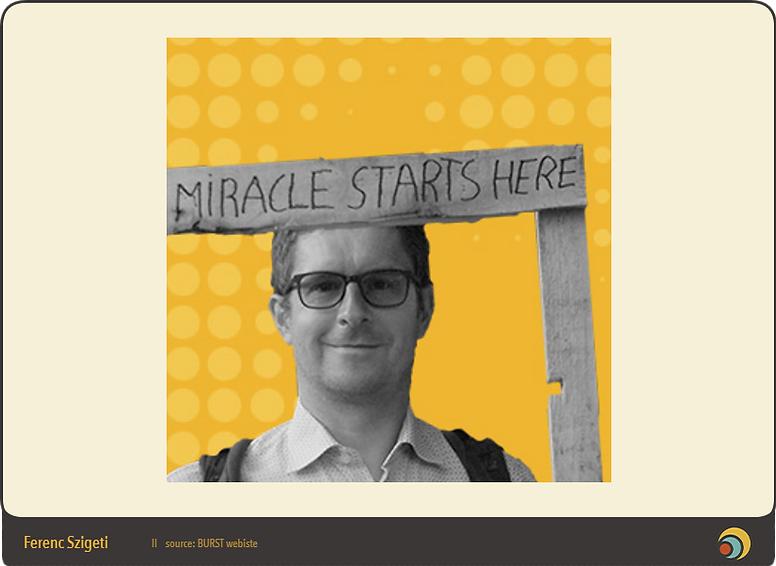Social services are under increased pressure due to an ageing population, a pressure that is increased in times of crisis. Meanwhile, civil society and democratic participation in local communities are in decline. An innovative social service model, the so-called people-powered services aim to solve problems. Burst’s own Ferenc Szigeti, former lead expert of the Urbact project CHANGE!, explains, how.
Could you please explain what people-powered services are?
Feri: By default, all social services offer professional support, which is very expensive. However, it is well known that many of these services could be carried out through volunteering. The main idea is to integrate volunteering into social services.
For example, to quote a Hungarian case, some older people go to the doctor in order to socialise. But of course, you don’t need to visit the doctor for that. However, if there is a neighbour who is also solitary (might be a younger person), a generalist can connect them and thus the relevant need is now serviced. Of course, the generalist is also connected to NGOs, CSOs, religious organisations, i.e., all relevant stakeholders in the social and volunteering sectors. The point of this is to provide social services on the lowest level possible. This is the main idea behind people-powered services
As far as I know, this idea came about when, during the financial crisis, European cities such as Eindhoven (CHANGE!’s lead partner) realised that there is an increasing demand for social services while their income was declining.
The idea of people powered services became a main topic of interest for NESTA, the UK’s social innovation agency and in general, they are perhaps most widespread in the UK. NESTA claims that if somebody can organise and integrate the British tradition of volunteering into public services can only be good. In their opinion, this should also be the future of public services. In the UK, the Cameron government introduced the community right to challenge in the Localism Act.
More generally, there was a lot of research on people-powered services done in the UK. For example, Hilary Cottam, author of the book Radical Help, researched social workers working with disadvantaged British families, and measured how much of their work is actually supporting these families and how much are administrative chores. The conclusion was that “classical” social services are not fit for our age.
First, these services are hierarchical. This is linked to the fact that the system puts no emphasis on capabilities (as theorised by Amartya Sen), focusing on giving material support only. This means that people in need are positioned as having no agency. However, successful social services should be empowering, local and based on social cohesion. Finally, for young people or for the elderly, peer-to-peer support is known to be more effective than professional support but this is ignored by services.
A good example of this is Family by Family, where families supported at-risk new families in Australia. There were access projects where companies and university students gave one hour of mentoring a week to students from disadvantaged backgrounds.
Social innovation should be about creating not only new social services and products but also new social relations. And that is key here: as a NESTA conference’s slogan once said, “Unlikely connections, boosting social action”. That is what you need in the Hungarian context, too, to facilitate meetings between, say, rural and urban residents so that they will know they have more in common.
NESTA also created a fund for people-powered services and social innovation. Perhaps the sexiest initiative was “Good Gym”, which was created by a running enthusiast who connected up running and doing good (e.g., doing shopping for elderly citizens). NESTA gave seed money for this and many similar initiatives.
This should result in more efficient – and yes, cheaper – social services.

But what are the downsides and limits of PPS?
There are a lot of those. First, I have to mention that there is a general scepticism about the idea. Even within the context of the project we received a lot of “but can it work in Eastern Europe?” questions. Which was quite shocking.
Second, as I have mentioned, the PPS model builds upon volunteering. However, how willing people are to volunteer differs country by country. In Central and Eastern Europe, after the socialist period, volunteering is less widespread, even if the trends are good. This has an effect on the availability of volunteering to be channelled into social services.
We had a Hungarian partner, Nagykanizsa. At the time of the project, the Hungarian government introduced a mandatory community service for secondary school students (students need to perform at least 40 hours of volunteering as a prerequisite for being able to take their final exams). That was a significant amount of volunteer work. If somebody, a municipality or an NGO put enough effort into this work, that would be enough to make significant change. However, CSOs and municipalities cannot match volunteers to meaningful work, therefore they would do meaningless chores (cleaning streets and the like) for 40 hours.
Another problem was the lack of engagement: it doesn’t work overnight. During the project we had the mid-term review of WeEindhoven. It turned out that WeEindhoven was initially more expensive (while the aim was to lower the cost of social services). Social cohesion, on the other hand, is less measurable.
This sounds a lot like municipalities making citizens voluntarily carry out their duties. After all, at least in Hungary, municipalities are legally required to provide social services… Long term, this might also mean that there are negative attitudes towards the municipalities and social services are dismantled.
This criticism was mirrored by many in Eastern European partner countries. However, if you look at it this way, placemaking, too, is a way to outsource a public service to citizens, and yet that works all over the world. Of course, there you don’t need to help people.
Social services aren’t dismantled because at least some of the needs still require professional support. However, many of the needs will not now be serviced by professional services, because they need not be.
Furthermore, to organise opportunities for citizens is extremely laborious. We had, for example, an Irish partner, where they have a centralised network for people-powered services, the Public Participation Network. There, municipalities were required to have citizen consultations organised in various policy areas. You can do this on paper, without real impact, but the real challenge is to have citizens feel that their sense of community and willingness to act is supported. To create a platform where citizens are treated equally and heard (as opposed to mere consultations) is a challenge in Ireland and the Netherlands, too, and you need time for these systems to function properly. It is no surprise, therefore, that in some countries this model couldn’t succeed.
In the UK, the community right to challenge received a lot of criticism, too, which is to be expected in such a paradigm shift.
Do people-powered services hurt the quality of services by using untrained volunteers instead of professionals? For instance, by mistreating a situation or by not recognising when more professional help is needed…
This is the point where we need to emphasise that this is only to supplement, not to replace, existing social services. For example, for a lot of elderly citizens, some volunteers spending time talking with them for an hour or two is a game changer. There is a famous example from a Dutch university town, where housing prices skyrocketed so that many students were not able to find accommodation. However, in the municipal care home, there were many vacancies. The municipality offered free accommodation for students, in exchange for volunteering with the care home residents. Of course, this did not mean specialised care work, but to go walk with them, play board games with them, and so on. This benefitted both sides, as volunteering, too, has quite significant mental health benefits. In essence, this was the people-powered services model implemented on a smaller scale: professional support for those who actually need it, with help that doesn’t need professionals provided through volunteering, which saves money but also creates social cohesion.
So, how did CHANGE! look like? And what were the main success stories?
In Eindhoven they created WeEindhoven, which was one of the most complex people-powered service models at the time. In WeEindhoven, they have divided up the city into zones and retrained social workers into generalists. Generalists were responsible for a neighbourhood, mapping needs and opportunities. Then, they channel volunteering into these communities.
To support this, they led an Urbact project, CHANGE!, where 9 cities exchanged experiences, involved stakeholders, and ended up developing action plans. This is not the most concrete of results, but can be very useful to learn some of the cutting edge international practices. This was the main motivation of Eindhoven, too.
Success stories are more complicated. Aarhus, the second largest Danish city, was a partner. Aarhus was also the European Capital of Culture at the time. This being Denmark and an innovation-minded milieu event within that, the Aarhus Municipality loved this project. However, what they started were things they probably would have started anyway, with the project helping them learn methodologies. For example, they worked with long-term unemployed people, giving them personal budgets that they can spend as they like. If a person wants to buy clothes so that they can have suits for work interviews, or they invest it and start a new company. This was a national success in Denmark – and this was only one of the five initiatives. They also created a youth platform for young people from abroad (expats and university students) to be able to find the right company for themselves. This was to ensure they feel at home at Aarhus and will remain there after graduation.
At one of the cities, to quote a not so successful example, we started to work with a promising initiative to have students volunteer with elderly residents (e.g., by teaching them English). However, this effort was soon halted for political reasons, as the municipality was seeing that they are losing control.
In Eindhoven, they felt like the project was successful, even though their system was much more complex than others’, so they could not learn that much from the project. Overall, partners were satisfied, even if there were no big, concrete outcomes due to the limitations of Urbact.
Finally, what are the main challenges to introduce people-powered services?
The first is epistemic: many municipalities aren’t aware of this concept and lack the knowledge to run such services.
Another issue is that there are limitations to national legislations. In Hungary, for example, these tend to be drawn up with a centralising mindset, which makes implementing people-powered services harder. Even so, municipalities could act as brokers matching interest groups to each other. The question is, will you do this on paper alone, by creating an “ageing council”, or will you put all the required energy into it, and perhaps even some budget. They can also organise school community services. Even a Hungarian municipality can have these opportunities – even if they are not in a position to organise a system of people-powered services.

Ferenc Szigeti the lead expert of the Urbact project CHANGE!. Feri is a geographer who have worked in the field of sustainable urban development for more than 15 years. He previously worked at the Managing Authority for Regional Operative Programmes, where he co-designed the Programme’ ESF priority and was responsible for the implementation of ESF measures. He has worked on several Interreg and Urbact projects, as project developer, project manager or lead expert. (He briefly mentions placemaking in the interview, which is no surprise considering he was the Lead Expert of Come In!, too.) Beside his work in urban development, Feri is a journalist documenting the natural beauties and hiking locations of Hungary.
